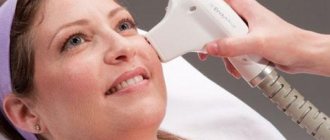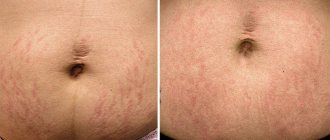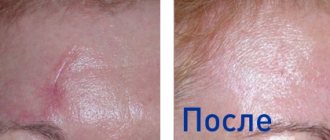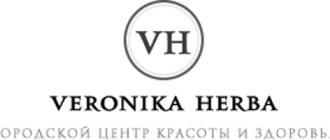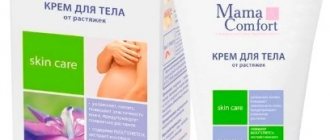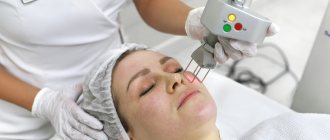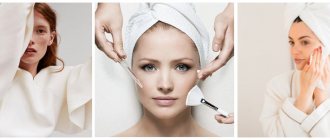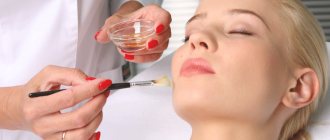Beauty is a passing thing, and in order to have a radiant appearance as long as possible, it is necessary to preserve it. Cosmetic products cannot always cope with defects such as loose, uneven, pigmented skin and age-related changes. Thousands of women have become convinced that the most effective procedure in this case is laser facial resurfacing (LOF). This type of resurfacing can be performed on the entire face or certain areas of it. But, on the way to ideal skin, it is worth remembering that after the procedure it is important to strictly follow all the doctor’s recommendations.
What to do during the healing period?
After laser resurfacing, a special coating is applied to the skin, which performs protective and restorative functions. After removing it, solcoseryl ointment is applied to the treated area of the face. For a week, the procedure for applying this ointment should be carried out daily using the following technology:
- remove remaining ointment with chlorhexidine solution;
- make a lotion (15 minutes) by moistening a gauze pad in a slightly pink solution of potassium permanganate (mix 3-4 drops of the concentrated product with cold saline);
- apply solcoseryl ointment (after the 3rd day - “Bepanten” until the skin is completely restored).
It is extremely important to carry out this procedure at least three times a day for 3-7 days until the healing period is over.
After the procedure
After the end of the procedure and the action of the anesthetic substance, a tingling sensation and mild pain may occur. The skin will turn red and develop slight swelling. The degree of discomfort depends on the depth and intensity of the impact, as well as on individual characteristics. All these processes are normal and accompany skin renewal and rejuvenation. After 3-4 days, minor crusts appear on the surface of the treated area, which soon peel off, leaving behind fresh, young and tightened skin without scars, spots and other defects.
After the procedure, it is important to follow the doctor’s recommendations, apply medicinal creams prescribed by him, and not expose the treated areas to additional exposure or trauma. It is extremely important to avoid tanning beds and direct sunlight for a month after resurfacing. Depending on the level of laser exposure, rehabilitation lasts 2-3, 5-7, 10-14 days after superficial, medium and deep resurfacing, respectively.
General recommendations
Two weeks later, after the formation of a new surface layer of skin, provided that there are no side effects such as redness, burning or itching, you can carefully proceed to normal facial skin care. At this time, it is not recommended to use new, untested products to avoid allergic rashes. Also, keep in mind that renewed skin is still very sensitive to sunlight. Therefore, to avoid hyperpigmentation, use special sunscreens with a high degree of protection (3 months). There should be no painful sensations: if they occur, consult a doctor immediately.
Contraindications
Laser resurfacing is contraindicated in the following cases:
- pregnancy, lactation period;
- diabetes, lupus erythematosus;
- epilepsy;
- HIV, hepatitis C, oncology;
- tendency to keloid scars, blood clotting disorders;
- increased susceptibility to light and thermal radiation.
In these cases, cosmetologists recommend postponing the procedure:
- skin dehydration;
- colds and viral diseases;
- exacerbation of chronic pathologies;
- psoriasis, fungal infection;
- recovery period after surgery.
Resurfacing cannot be done for six months after taking medications with vitamin A. For chronic herpes, you need to take antiherpes medications so as not to provoke its appearance after the procedure.
A relative contraindication is dark skin. This phototype has a genetically programmed increased activity of melanocytes. The reaction to the procedure is unpredictable even if all the rules are followed. Post-traumatic pigmentation may appear, and the complexion will become uneven.
Rules for facial care after laser resurfacing:
- For the first week after the procedure, minimize washing: it is not recommended to moisturize the skin;
- sleep only on your back;
- reduce facial expressions;
- eat a balanced diet, without spicy foods;
- exclude alcoholic drinks (at least 7 days);
- and try not to smoke;
- physical activity is prohibited due to the inadmissibility of increased blood flow to the head;
- seven days after the procedure, the skin begins to peel off. From this period, it is recommended to use a moisturizer with vitamin E.
After laser facial resurfacing, you will be observed by a doctor for another 10 days, so it is not recommended to travel far outside the city. With proper skin care, the duration of the recovery period is significantly reduced, and the possibility of side effects is reduced significantly.
Progress of the procedure
At the Federal Scientific and Clinical Center FMBA, rejuvenation is carried out using the Fraxis fractional CO2 laser.
Before the procedure, the skin is cleansed and toned. Then an anesthetic in the form of a cream is applied to the treated area, and when the skin loses pain sensitivity, the doctor begins the laser rejuvenation procedure itself. Laser beams are applied to the skin through a special attachment, which may cause a feeling of warmth or a slight tingling sensation, but not pain.
There are three types of grinding depending on the depth of exposure to the CO2 laser: superficial, medium and deep.
When carrying out surface resurfacing, the effect is only on the epidermis; in fact, a light laser peeling is carried out. The objectives of surface resurfacing are to even out the complexion, remove superficial dyschromia and enlarged pores. Medium resurfacing is carried out at more intense parameters and deeper, already in the middle layers of the dermis in order to treat wrinkles, post-acne scars and other skin problems.
Deep resurfacing is a procedure that is carried out at the maximum possible depth for the laser and at fairly aggressive parameters. Its goal is to stimulate total skin rejuvenation, treat wrinkles, unevenness and skin defects, as well as skin lifting, the result of which is often comparable to the result after plastic surgery.
Laser rejuvenation is applicable to various areas of the face, neck, décolleté, buttocks, knees, skin of the abdomen and chest, hands and other areas of the skin.
Peeling result
The purpose of laser deep peeling is to start the process of skin rejuvenation. After the recovery period, the following result is achieved:
- the epidermis is renewed: the skin becomes smooth;
- Collagen is intensively produced: this makes the skin elastic and taut;
- scars and stretch marks disappear;
- melanin is redistributed: pigment spots lighten;
- the vascular network on the skin decreases;
Patients who wish to get rid of unwanted tattoos can do so with deep laser peeling. The procedure is performed to correct lips, eyebrows, and eyelids.
Face cleaning
At home, cleansing the skin of the face does not always give the desired result if its characteristics include increased oiliness. Then you should contact a specialist who will carry out professional cleaning. In addition, it complements peeling well.
The purpose of the procedure is to clean pores mechanically or mechanically, nourish, moisturize the skin, eliminate blackheads and smooth out unevenness, exfoliate the stratum corneum. Cleaning can be:
- Mechanical (manual) is the most effective way to remove pustular rashes and comedones, including deep ones. Suitable for oily and combination skin.
- Hardware - ultrasonic or vacuum peeling, stimulates blood circulation and lymphatic drainage, cleanses pores and massages the skin. Suitable for both normal and oily types.
Before cleansing, the skin must be prepared to maximize the effect of the procedure. This preparation includes: removing makeup and thoroughly cleansing using a scrub, toning the day before and in the morning. For dry skin, you should make a nourishing mask. Immediately before the procedure, the skin is steamed and treated with an antiseptic.
After cleansing, the skin should recover. This usually happens within 3 days if you follow all the rules of care after cleansing your face.
Care after mechanical cleaning requires special attention, as the skin is injured and wounds, inflammation, and red spots may appear. A rash may also appear if one of the wounds becomes infected.
What can't you do?
The use of scrubs and other aggressive cleansers is not recommended. Physical activity, thermal procedures, sunbathing and visits to the solarium are limited during rehabilitation. You cannot separate the crusts yourself. Usually 3 days are enough. After this, you can switch to regular skincare products.
Types of scars
To understand how to remove a scar after removing a mole, you need to determine what kind of complication the person has encountered. The method of treatment depends on the correct diagnosis:
- An atrophic scar (popularly “pockmark”) looks like a pit, is located below the level of the epidermis and most often occurs on flabby age-related skin.
- Hypertrophic scar , on the contrary, looks convex, rises above the skin, but does not grow beyond the boundaries of the original wound.
- Normotrophic . Does not spoil the appearance, as it is flat and flesh-colored.
- Keloid scar . The most disturbing of all is located above the skin level and can grow over several years, significantly exceeding the size of the original wound. It itches, hurts, has a burgundy or bluish color.
Since the last type of scar on the list causes the most inconvenience, we will tell you about it in more detail.
Stages of keloid scar formation
Despite the development of medicine, the causes of keloid scars are still unknown. Presumably these could be:
- weakened immune system;
- damage to the epidermis in the deep layers;
- allergy;
- diabetes;
- imbalance of hormones in the body;
- heredity;
- pregnancy;
- genetic characteristics (Asians and dark-skinned people are more likely to develop keloids).
If close relatives have keloid scars, there is a high probability that you will also develop them, even without visible trauma to the skin or due to a tiny cut.
A keloid forms a year after the removal of a mole in the form of overgrown tissue at the site of the scar. Redness appears, the skin looks inflamed and the size of the scar soon increases noticeably.
The keloid can be smooth or lumpy to the touch and rises above the rest of the skin by about 8–10 mm. Its growth continues from 2 to 5 years, during this period the keloid becomes rougher, screeds appear and repeated damage is provoked. Even after excision of such a scar through surgery, relapse cannot be avoided.
After the specified period, the trail does not change for many years.
How to get rid of a scar?
Methods to remove a scar after removing a mole depend on the degree of complexity of the task:
- at the very beginning of scar formation, applications with a softening ointment with an antibacterial effect ;
- at the first symptoms of the appearance of a keloid, silicone plates and gels , putting pressure on the scar, thereby preventing its growth;
- cosmetic procedures , for example, peelings with acids. They are effective in the first stages of scar formation, when it is in the active growth phase. But laser resurfacing is recommended to be carried out after the final formation of the scar. Excessive trauma to the scar can only provoke its growth and you need to be especially careful in choosing a procedure;
- in case of a serious problem, surgical excision of the scar and prevention of further growth of excess collagen;
- for a large scar area, physiotherapy is prescribed : for example, electrophoresis with cosmetics or medications, as well as ultrasound or microcurrent therapy;
- injections of corticosteroids (hormones) into the scar , but not more often than once a month.
Remember that most of the listed procedures have contraindications. Before deciding on a particular scar correction method, consult your doctor!
Scar excision is a complex and risky procedure; if done incorrectly, relapse is guaranteed. Therefore, experts recommend that the surgery be performed by a qualified, experienced surgeon in a hospital or clinic.
The method of tight bandaging - bandages (compression garments) - also does not always bring results, and injections additionally injure the scar with a needle, which can cause a relapse, and the drugs for injections are not cheap.
Applications with ointments and physiotherapy are the most accessible and safe for the patient: they are carried out either in a clinic at the place of residence or with the help of special devices.
Practicing dermatologist Svetlana Viktorovna Ogorodnikova recommends Fermenkol gel as an ointment for scars after mole removal.
Find out which method of correcting scars and stretch marks is optimal for you!
doctor Svetlana Viktorovna Ogorodnikova.
doctor
